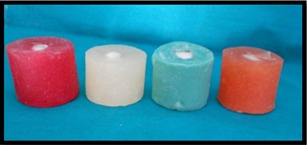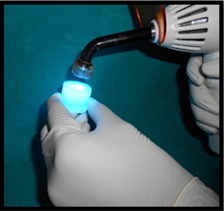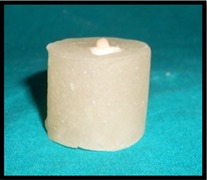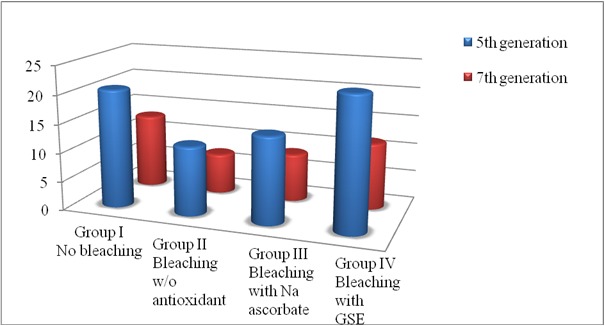Abstract
Background: The objective of this in-vitro study was to evaluate the effect of grape seed extract (oligomericproanthocyanidin complexes [OPCs]) on the bond strength of composite resin to bleached enamel using 5th and 7th generations of bonding agents. Materials & Methods: Eighty maxillary central incisors were randomly assigned to four groups as follows: Group I (n=20): no bleaching (control); Group II (n=20): bleaching with 38% hydrogen peroxide gel, without the use of an antioxidant; Group III (n=20): bleaching followed by the use of 10% sodium ascorbate; Group IV (n=20) : bleaching followed by the use of 5% proanthocyanidin solution. All the four groups were further subdivided into two groups of ten teeth each depending on the adhesive system used in order to bond the resin composite to enamel surfaces. Subgroup A: 5th generation bonding agent and subgroup B : 7th generation bonding agent. Shear bond strength of the specimens was tested under universal testing machine. Results: The shear bond strength values were observed to be significantly higher in teeth treated with 10% sodium ascorbate and 5% proanthocyanidin as compared to the group in which no antioxidant was used. Also, bonding with 5th generation bonding agent resulted in significantly higher shear bond strength when compared to the 7th generation bonding agent. Conclusion: The use of grape seed extract as an antioxidant after bleaching significantly improves the bond strength of composite resin to bleached enamel. 5th generation bonding agents have higher shear bond strength of composite resin to enamel. How to cite this article: Abraham S, Ghonmode WN, Saujanya KP, Jaju N, Tambe VH, Yawalikar PP. Effect of grape seed extract on bond strength of bleached enamel using fifth and seventh generation bonding agents. J Int Oral Health 2013; 5(6):101-7 .
Key words: : Antioxidants, bond strength, bonding agents
Introduction
Vital tooth bleaching has gained popularity due to increasing interest in esthetic dentistry as a conserva-tive treatment modality for discoloured teeth. 1 The commonly used bleaching agents contain high concentrations of carbamide peroxide (35% to 37%) or hydrogen peroxide (30% to 38%). 2 These oxidizing agents have a significant ability to lighten the tooth but the adverse effects they produce have been a subject of concern. Several complications such as pulp irritation, tooth structure alterations, microleakage of restorations, and reduced bond strength of composite resin to tooth structure might arise. Some studies have also reported changes in enamel, including increased porosity and an over-etched appearance along with the loss of prismatic enamel structure, calcium loss, reduced micro hardness, and changes in the organic component of enamel. 3 , 4 One of the important complications seen is a reduction in bond strength of composite resin to bleached enamel when bonding is performed immediately after the bleaching process. The mechanism suggested for this is the presence of residual free oxygen radicals that interferes with resin polymerization. 5 , 6
Some techniques, like treating the bleached enamel with alcohol before restoration 7 , removal of the superficial layer of enamel 8 and use of adhesives containing organic solvents 9 , 10 improves the bond strength to bleached enamel. However, it has been recommended to delay the bonding procedure for at least a week for enamel to return to normal conditions. For immediate reestablishment of esthetics, this delay in bonding procedure can be overcome by use of several antioxidants such as sodium ascorbate. 6 , 11 Several naturally occurring antioxidants like grape seed extract containing oligomericproanthocyanidin complexes have demonstrated potency 50 times greater that sodium ascorbate. 12 , 13
For bonding composite resin to enamel, two most commonly used adhesive systems are: ‘etch and rinse’ (5 th generation) in which there is a separate etching step with 37% phosphoric acid followed by rinsing with water prior to application of primer/adhesive and the other is ‘self-etch’ (7 th generation) in which there is no separate etching step, rather bonding is achieved by application of a single solution which contains an acid monomer which simultaneously etch, infiltrate and polymerize. 14 The self-etch system is an easy and time saving approach for the clinician as it comprises a single step. However, with these 7 th generation adhesive systems a compromise in enamel bond strength has been found.
The aim of this in-vitro study was to evaluate the effect of grape seed extract (oligomericproanthocyanidin complexes [OPCs]) on the bond strength of composite resin to bleached enamel and to compare the efficacy of 5th and 7 th generations of bonding agents.
Materials and Methods
-
Preparation of solutions:
Two solutions were prepared to conduct this study:
10% sodium ascorbate solution was prepared by dissolving 10 g of sodium ascorbate (Reckon Pharmachem Ltd.) in 100 ml of distilled water.
5% proanthocyanidin solution was prepared by dissolving 5 g of grape seed extract in the form of powder (Vedeesh Herbals) in 100 ml of distilled water.
-
Specimen preparation:
Eighty recently extracted maxillary central incisors were collected. The crowns were separated from their roots using a diamond disk. The crown segments were fixed, with the exposed enamel down, on double-sided adhesive tape on a glass slide. They were then embedded in self-curing resin by placing a mold that was open on both ends on the adhesive tape and filling the mold with the mixed resin. The labial surfaces were ground flat using 600-grit sandpaper on a polishing machine.
The specimens were randomly divided into four groups of twenty teeth each based on the bleaching
regimen followed ( Figure-1 ). Each group was further divided into two subgroups based on the generation of bonding agent used for the bonding procedure (Table 1).
Figure 1: Specimens distributed in four groups.

Table 1: Distribution of specimens and study groups.
| GROUP | ANTI OXIDANT USED | SUB GROUP | BONDING AGENT USED |
| Group I (Control) | None | n | 5th Generation |
| (n=20) | (n=10) | (Prime & Bond NT) | |
| No bleaching | B | 7 th Generation | |
| (n=10) | (Xeno V) | ||
| Group II | None | A | 5th Generation |
| (n=20) | (n=10) | (Prime & Bond NT) | |
| Bleached | B | 7th Generation | |
| Specimens | (n=10) | (Xeno V) | |
| Group III | 10% sodium ascorbatesolution | A | 5 th Generation |
| (n=20) | (n=10) | (Prime & Bond NT) | |
| Bleached | B | 7th Generation | |
| Specimens | (n=10) | (Xeno V) | |
| Group IV | 5% proanthocyanidinsolution | A | 5 th Generation |
| (n=20) | (n=10) | (Prime & Bond NT) | |
| Bleached | B | 7th Generation | |
| Specimens | (n=10) | (Xeno V) |
The labial enamel surfaces of 60 specimens were bleached with 38% hydrogen peroxide gel
(Opalescence Xtra Boost) for 10 minutes. The bleaching gel was completely rinsed off with water. Twenty teeth served as controls (Group I) and did not receive any bleaching treatment. In Group IA, the labial surface of each specimen was etched with 37% phosphoric acid for 15 seconds, rinsed with water for 20 seconds and bonded with Prime & Bond NT. This was then followed by composite resin build-up of 3mm diameter and 3 mm height (Figure – 2 , 3 ). In Group IB, the labial surface of each specimen was etched with 37% phosphoric acid for 15 seconds, rinsed with water for 20 seconds and bonded with Xeno V as per the manufacturer’s instructions. This was followed by composite build-up of 3mm diameter and 3 mm height. In Group IIA, the specimens were bleached and rinsed followed by composite build up similar to Group IA using Prime & Bond NT adhesive system. In Group IIB, the specimens were bleached and rinsed followed by composite build up similar to Group IB using Xeno V adhesive system.
Figure 2: Curing of composite resin.

Figure 3: Composite build-up of 3mm diameter and 3 mm height.

In Group IIIA, immediately after bleaching and rinsing, the labial surface of each specimen was treated with 10% sodium ascorbate for 10 minutes and then rinsed. This was followed by composite build up similar to Group IA using Prime & Bond NT adhesive system. In Group IIIB, immediately after bleaching and rinsing, the labial surface of each specimen was treated with 10% sodium ascorbate for 10 minutes and then rinsed. This was followed by composite build up similar to Group IB using Xeno V adhesive system.
In Group IVA, immediately after bleaching and rinsing, the labial surface of each specimen was treated with 5% proanthocyanidin solution for 10 minutes and then rinsed. This was followed by composite build up similar to Group IA using Prime & Bond NT adhesive system. In Group IVB, immediately after bleaching and rinsing, the labial surface of each specimen was treated with 5% proanthocyanidin solution for 10 minutes and then rinsed. This was followed by composite build up similar to Group IB using Xeno V adhesive system.
All the specimens were stored in distilled water for 24 hrs. Shear bond strength (SBS) testing was performed in a universal testing machine (Star Testing System). Bond strengths were calculated using the load required to debond the specimen and the area of resin composite. Mean bond strengths were calculated and the results were analyzed using a computer program (SPSS 12 for Windows, SPSS Incorporated, Chicago, IL, USA). Unpaired t-test was used for comparison
between the subgroups, i.e., the fifth and the seventh generation bonding agents. One way ANOVA
followed by Post hoc test using Bonferroni multiple comparison test was used to compare the data between various groups at the 0.05 significance level.
Results
The intra group comparison using unpaired t-test showed a statistically significant difference (p<0.001) between subgroup A (i.e., 5 th Generation bonding agent) and subgroup B (i.e., 7 th Generation bonding agent) (Table 2). The shear bond strength values were found to be higher when 5 th Generation bonding agent was used for bonding composite resin to enamel as compared to 7 th Generation bonding agent, in all the four groups. A significant reduction in the shear bond strength can be seen in Group II after bleaching as compared to the control group (Group I) in which no bleaching was done. The bond strength was found to be higher after the use of sodium ascorbate and grape seed extract as antioxidants. The values were significantly higher in Group IV in which grape seed extract was used when compared to Group II and III (p<0.001) in both the subgroups (Table 3). No statistically significant difference was seen between
Table 2: Intragroup comparison between 5th and 7th generation bonding agents (using unpaired t test)
| Group | Mean (MPa) | S.D. | T value | p value | |
| I | 5th generation | 20.65 | 1.03 | 18.927 | |
| 7th generation | 13.07 | 0.74 | |||
| II | 5th generation | 12.02 | 1.29 | 10.162 | < 0.001 |
| 7th generation | 7.13 | 0.82 | |||
| III | 5th generation | 15.04 | 1.12 | 10.188 | |
| 7th generation | 8.43 | 1.72 | |||
| IV | 5th generation | 22.91 | 3.70 | 8.646 | |
| 7th generation | 11.60 | 1.85 |
Table 3: Intergroup comparison (using one-way ANOVA)
| Sum of squares | Mean square | F value | Sig. | ||
| (Groups IA, IIA, IIIA, IVA) | Between groups | 750.880 | 250.293 | 56.588 | .000 |
| Within groups | 159.232 | 4.423 | |||
| Total | 910.112 | ||||
| (Groups IB, IIB, IIIB, IVB) | Between groups | 226.760 | 75.587 | 39.836 | .000 |
| Within groups | 68.308 | 1.897 | |||
| Total | 295.068 | 250.293 |
Group I (control) and IV amongst both the subgroups (p=0.129; p=0.131 respectively) (Table 4,5). The graphical representation of the results has been depicted in Graph 1 .
Table 4: Post hoc analysis (using Bonferroni multiple comparison test)
| GROUP (P) | GROUP (Q) | MEAN DIFF(P-Q) | SIG (p VALUE) |
| Group IA Control) |
Group IIA Group IIIA Group IVA |
8.624 5.604 -2.261 |
.000 .000 .129 |
| Group IIA (Bleaching w/o antioxidant) |
Group IA Group IIIA Group IVA |
-8.624 -3.02 -10.89 |
.000 .017 .000 |
| Group IIIA (Bleaching with Na ascorbate) |
Group IA Group IIA Group IVA |
-5.604 3.02 -7.865 |
.000 .017 .000 |
| Group IVA (Bleaching with GSE) | Group IA Group IIA Group IIIA |
2.261 10.89 7.865 |
.129 .000 .000 |
Table 5: Post hoc analysis (using Bonferroni multiple comparison test)
| GROUP (P) | GROUP (Q) | MEAN DIFF(P-Q) | SIG (p VALUE) |
| Group IB (Control) |
Group IIB Group IIIB Group IVB |
5.943 4.642 1.477 |
.000 .000 .131 |
| Group II (Bleaching w/o antioxidant) | Group IB Group IIIB Group IVB |
-5.943 -1.301 -4.466 |
.000 .025 .000 |
| Group III (Bleaching with Na ascorbate) | Group IB Group IIB Group IVB |
-4.642 1.301 -3.165 |
.000 .025 .000 |
| Group IV(Bleaching with GSE) | Group IB Group IIB Group IIIB |
-1.477 4.466 3.165 |
.131 .000 .000 |
Graph 1: Graph depicting the comparison between various groups.

Discussion
Sodium ascorbate is a neutral, nontoxic and biocompatible antioxidant that when used as 10% solution can reverse the reduced bond strength of bleached enamel by restoring the altered redox potential. 6 , 11 In the present study, the use of sodium ascorbate (Group III) had resulted in higher bond strength with both, 5 th (15.04 MPa) and 7 th (8.43 MPa) generation bonding agents, when compared to Group II (12.02MPa, 7.13MPa) in which no antioxidant was used. The results are in line with the findings of previous research done by Kimayi et al15, Bulut et al5 and Lai et al11
Proanthocyanidins are high molecular weight polymers that comprise the monomeric flavan-3-ol (þ) catechin and (-) epicatechin. They are found in high concentrations in natural sources such as grape seed extract, cranberries, pine bark extract, hazelnut tree leaves and lemon tree bark. As a naturally occurring plant metabolite, it has been proven to be safe as an antioxidant in various clinical applications and also in dietary supplements. 16
This study shows that treatment with 5% proanthocyanidin increases the bond strength significantly (22.91 MPa) when compared to other groups (II, III). This could be attributed to the following:
The specificity of OPCs for hydroxyl free radicals.
The presence of multiple donor sites on OPCs that trap superoxide radicals.
The esterification of epicatechin by gallic acid in OPCs, which enhances the free radical scavenging activity.
The present study also compared the seventh generation self-etching bonding agent (XenoV) with the fifth generation ‘etch-and-rinse’ adhesive (Prime & Bond NT). It was seen that the seventh generation bonding agent resulted in lower bond strength when compared to fifth generation bonding agent. It is in agreement with other studies that have shown seventh generation adhesives to be the less effective. 17 , 18 The lower bond strength of 7 th generation bonding agent might be a result of the less pronounced etching pattern obtained with the self-etch adhesive and inadequate pH of the primer.
Conclusion
Under the limitations of this study, it can be concluded that:
Treatment of bleached enamel surface with 5% proanthocyanidin reverses the reduced bond strength and results in significantly higher shear bond strength.
The shear bond strength with 5thgeneration bonding agent is significantly higher when compared to 7th generation bonding agent.
Footnotes
Source of Support: Nil
Conflict of Interest: None Declared
Contributor Information
Sathish Abraham, Department of Conservative Dentistry & Endodontics, SMBT Dental College & Hospital, Sangamner, Maharashtra, India.
Wasudeo Namdeo Ghonmode, Department of Conservative Dentistry & Endodontics, SMBT Dental College & Hospital, Sangamner, Maharashtra, India.
K P Saujanya, Department of Conservative Dentistry & Endodontics, SMBT Dental College & Hospital, Sangamner, Maharashtra, India.
Neha Jaju, Department of Conservative Dentistry & Endodontics, SMBT Dental College & Hospital, Sangamner, Maharashtra, India.
Varsha H Tambe, Department of Conservative Dentistry & Endodontics, SMBT Dental College & Hospital, Sangamner, Maharashtra, India.
Priya P Yawalikar, Department of Conservative Dentistry & Endodontics, SMBT Dental College & Hospital, Sangamner, Maharashtra, India.
References
- 1.CR Torres, AF Koga, AB Borges. The effects of antioxidant agents as neutralizers of bleaching agents on enamel bond strength. Braz J Oral Sci. 2006;5(16):971–976. [Google Scholar]
- 2.S Vidhya, S Srinivasulu, M Sujatha, S Mahalaxmi. Effect of grape seed extract on bond strength of bleached enamel. Oper Dent. 2011;36:433–438. doi: 10.2341/10-228-L. [DOI] [PubMed] [Google Scholar]
- 3.M Turkun, AD Kaya. Effect of 10% sodium ascorbate on the shear bond strength of composite resin to bleached bovine enamel. J Oral Rehabil. 2004;31:1184–1191. doi: 10.1111/j.1365-2842.2004.01369.x. [DOI] [PubMed] [Google Scholar]
- 4.T Attin, D Vollmer, A Wiegand, R Attin, H Betke. Subsurface microhardness of enamel and dentin after different external bleaching procedures. Am J Dent. 2005;18:8–12. [PubMed] [Google Scholar]
- 5.H Bulut, AD Kaya, M Turkun. Tensile bond strength of brackets after antioxidant treatment on bleached teeth. Eur J Orthod. 2005;27(5):466–471. doi: 10.1093/ejo/cji044. [DOI] [PubMed] [Google Scholar]
- 6.M Turkun, EU Celik, AD Kaya, M Arici. Can the hydrogel form of sodium ascorbate be used to reverse compromised bond strength after bleaching? J Adhes Dent. 2009;11(1):35–40. [PubMed] [Google Scholar]
- 7.N Barghi, JM Godwin. Reducing the adverse effect of bleaching on composite-enamel bond. J Esthe Resto Dent. 1994;6(4):157–161. doi: 10.1111/j.1708-8240.1994.tb00852.x. [DOI] [PubMed] [Google Scholar]
- 8.E Cvitko, GE Deheny, EJ Swift, Jr, JA Pires. Bond strength of composite resin to enamel bleached with carbamide peroxide. J Esthe Resto Dent. 1991;3(3):100–102. doi: 10.1111/j.1708-8240.1991.tb00976.x. [DOI] [PubMed] [Google Scholar]
- 9.T Kalili, AA Caputo, R Mito, G Sperbeck, J Matyas. In vitro toothbrush abrasion and bond strength of bleached enamel. Pract Periodont Aesthet Dent. 1991;3(5):22–24. [PubMed] [Google Scholar]
- 10.EC Sung, SM Chan, R Mito, AA Caputo. Effect of carbamide peroxide bleaching on the shear bond strength of composite to dental bonding agent enhanced enamel. J Prosthet Dent. 1999;82(5):595–599. doi: 10.1016/s0022-3913(99)70060-0. [DOI] [PubMed] [Google Scholar]
- 11.SC Lai, YF Mak, GS Cheung, R Osorio, M Toledano, RM Carvalho, FR Tay, DH Pashley. Reversal of compromised bonding to oxidized etched dentin. J Dent Res. 2001;80(10):1919–1924. doi: 10.1177/00220345010800101101. [DOI] [PubMed] [Google Scholar]
- 12.AM Fine. Oligomericproanthocyanidin complexes: history, structure, and phytopharmaceutical applications. Alternative Medicine Review. J Clin Ther. 2000;5(2):144–151. [PubMed] [Google Scholar]
- 13.J Shi, J Yu, JE Pohorly, Y Kakuda. Polyphenolics in grape seeds: Biochemistry and functionality. J Med Food. 2003;6(4):291–299. doi: 10.1089/109662003772519831. [DOI] [PubMed] [Google Scholar]
- 14.D Patil, KP Singbal, S Kamat. Comparative evaluation of the enamel bond strength of 'etch-and-rinse' and 'all-in-one' bonding agents on cut and uncut enamel surfaces. J Conserv Dent. 2011;14(2):147–150. doi: 10.4103/0972-0707.82616. [DOI] [PMC free article] [PubMed] [Google Scholar]
- 15.S Kimyai, SS Oskoee, A Rafighi, H Valizadeh, AA Ajami, ZN Helali. Comparison of the effect of hydrogel and solution forms of sodium ascorbate on orthodontic bracket-enamel shear bond strength immediately after bleaching: An in vitro study. Indian J Dent Res. 2010;21(1):54–58. doi: 10.4103/0970-9290.62818. [DOI] [PubMed] [Google Scholar]
- 16.Q Xie, AK Bedran-Russo, CD Wu. In vitro remineralization effects of grape seed extract on artificial root caries. J Dent. 2008;36(11):900–906. doi: 10.1016/j.jdent.2008.07.011. [DOI] [PMC free article] [PubMed] [Google Scholar]
- 17.J Perdigao, S Geraldeli. Bonding characteristics of self-etching adhesives to intact versus prepared enamel. J Esthet Restor Dent. 2003;15(1):32–41. doi: 10.1111/j.1708-8240.2003.tb00280.x. [DOI] [PubMed] [Google Scholar]
- 18.RE Kerby. Microtensile bond strengths of one-step and self-etching adhesive systems. Oper Dent. 2005;30(2):95–200. [PubMed] [Google Scholar]


